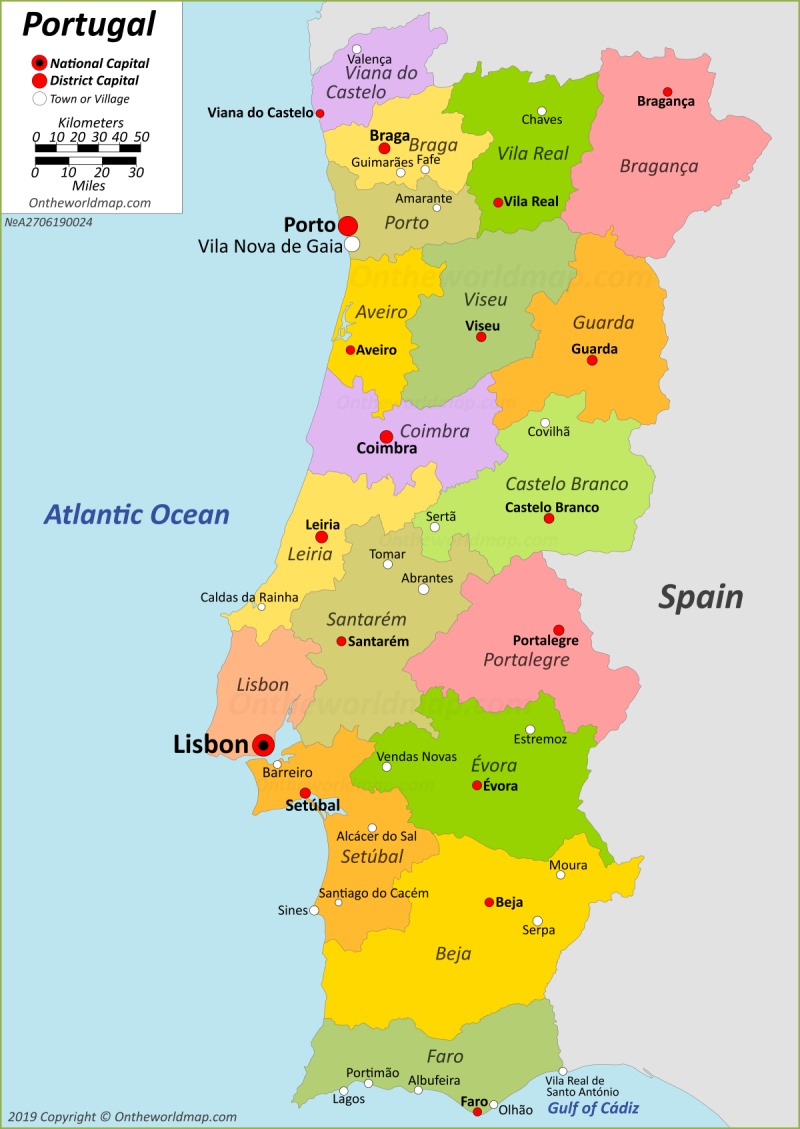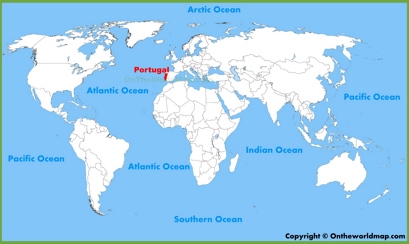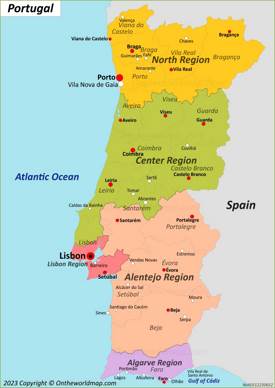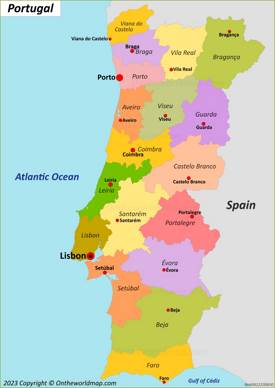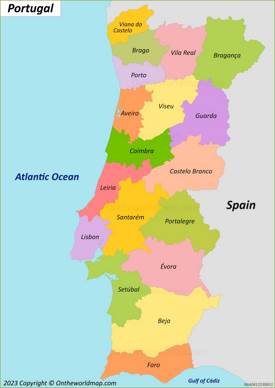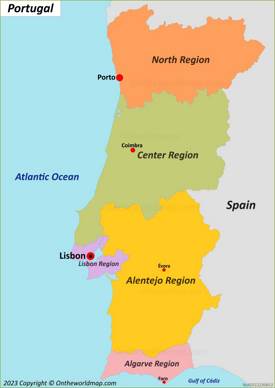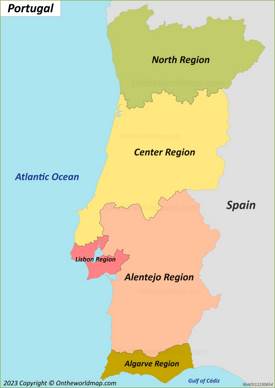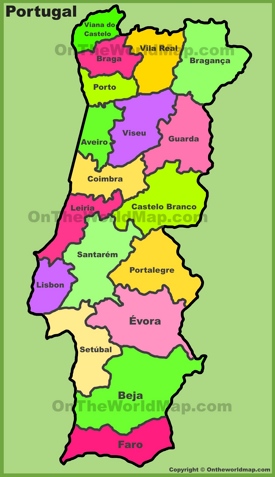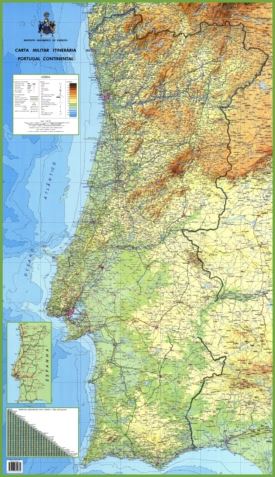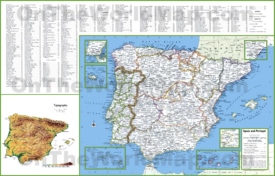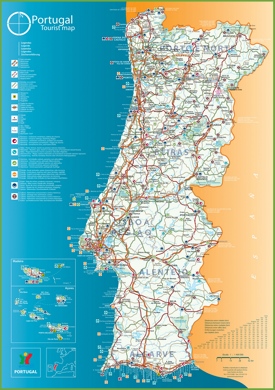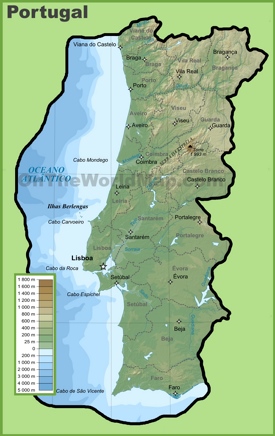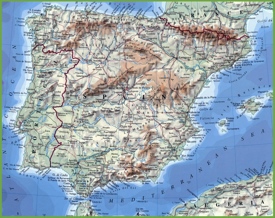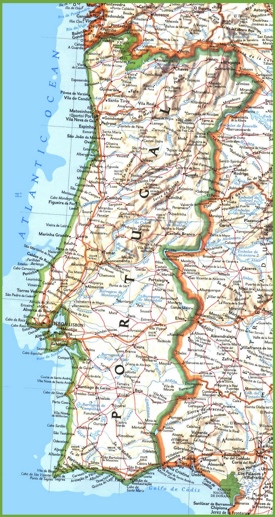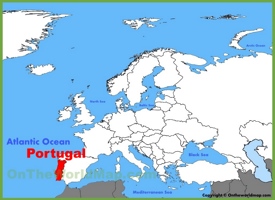Portugal Map
Description:
This map shows governmental boundaries of countries; districts, district capitals, and major cities in Portugal.
Size: 800x1128px / 117 Kb
Author: Ontheworldmap.com
You may download, print or use the above map for educational, personal and non-commercial purposes. Attribution is required. For any website, blog, scientific research or e-book, you must place a hyperlink (to this page) with an attribution next to the image used.
Online Map of Portugal
About Portugal
Portugal (officially the Portuguese Republic) occupies the westernmost portion of the Iberian Peninsula in Southern Europe. The country borders Spain to the north and east, while the Atlantic Ocean borders its western and southern coasts. The territory also includes two autonomous regions: the archipelagos of Madeira and the Azores in the Atlantic Ocean.
The country covers an area of 35,610 square miles (92,230 square kilometers), making it one of the smaller countries in Europe. Portugal maintains a population of 10.6 million people as of 2023, with most residents concentrated in the coastal regions near Lisbon and Porto.
Lisbon serves as the capital and largest city, with approximately 567,000 residents in the city proper and 3 million in the metropolitan area. The city functions as Portugal's primary economic and political center. Porto, the second-largest city, holds significant importance as a commercial hub and stands as the center of the northern region, particularly notable for its port wine production and export industry.
The Portuguese economy relies heavily on services, manufacturing, and tourism. The country maintains strong sectors in automotive manufacturing, textiles, footwear, and cork production – Portugal produces about 50% of the world's cork. The technology sector has shown significant growth, with major international companies establishing operations in Portuguese cities. The country's membership in the European Union and use of the euro currency facilitate international trade and investment.
Tourism represents a crucial component of Portugal's economy, contributing approximately 15% to the GDP. The country attracts visitors with its extensive coastline, featuring numerous beaches and surf spots. The Algarve region in the south draws millions of tourists annually with its Mediterranean climate and coastal resorts. Historic cities like Porto, Coimbra, and Lisbon offer well-preserved medieval architecture, museums, and historic districts. The country contains 17 UNESCO World Heritage sites, including the Tower of Belém, Jerónimos Monastery, and the historic center of Porto.
Portugal's climate varies from north to south, with the north experiencing mild temperatures and significant rainfall, while the south maintains a Mediterranean climate with warmer temperatures and less precipitation. This diverse climate supports various agricultural activities, including wine production in the Douro Valley, olive cultivation, and cork oak forests.
The Portuguese language, spoken by approximately 250 million people worldwide, reflects the country's historical influence through its former colonial empire. Brazil, Angola, Mozambique, and several other nations maintain Portuguese as their official language, creating significant cultural and economic ties with Portugal.
The country maintains a developed infrastructure network, including modern highways, high-speed rail connections, and three major international airports in Lisbon, Porto, and Faro. The Port of Sines serves as one of Europe's largest deep-water ports, facilitating international trade.
Natural resources include fish stocks in the exclusive economic zone, which spans approximately 1,727,408 square kilometers of the Atlantic Ocean. The country also maintains significant mineral deposits, including copper, lithium, tungsten, and tin. Portugal leads in renewable energy utilization, with wind and solar power contributing substantially to its energy grid.
The education system includes 15 public universities and numerous polytechnic institutes. The University of Coimbra, founded in 1290, ranks among the oldest continuously operating universities in the world. Portuguese research institutions maintain strong positions in marine science, biotechnology, and engineering fields.
The Facts:| Capital: | Lisbon |
| Area: | 35,610 sq mi (92,230 sq km) |
| Population: | ~ 10,639,726 (2023 estimate) |
| Official language: | Portuguese |
| Religion: | 84.8% Christianity - 80.2% Catholicism - 4.6% other Christian 14.1% no religion |
| Currency: | Euro (€) (EUR) |
| Driving side: | right |
| Calling code: | +351 |
| Internet TLD: | .pt |
| Official government website: | www.portugal.gov.pt |
| Official tourism website: | www.visitportugal.com |
Google Map of Portugal
List of Largest Cities in Portugal
- Aveiro (81,000)
- Queluz (79,300)
- Barreiro (78,300)
- Faro (68,000)
- Ponta Delgada (67,200)
- Póvoa de Varzim (64,300)
- Portimão (60,200)
- Montijo (55,700)
- Évora (53,500)
- Rio Tinto (51,500)
The Best Coastal Towns and Cities in Portugal: Albufeira, Câmara de Lobos, Olhão, Lagos, Ponta Delgada, Vilamoura, Comporta, Cascais, Costa da Caparica, Azenhas do Mar, Tavira, Costa Nova, Quarteira, Porto Covo, Peniche, Odeceixe, Ericeira, Praia da Rocha, Vila do Conde, Porto Moniz, Sesimbra, Nazaré, Ferragudo, Viana Do Castelo.
Main sights in Portugal: Jerónimos Monastery, Lisbon Oceanarium, Sanctuary of Bom Jesus do Monte, Belém Tower, Sintra National Palace, São Jorge Castle, Clérigos Church, Convent of Christ, University of Coimbra, Castle of Guimarães, Calouste Gulbenkian Museum, Praia da Marinha, Palace of Mafra, Palácio da Bolsa, Capela dos Ossos, Cabo Girao.
Districts of Portugal
| District | Population | Area (sq mi) | Area (sq km) |
|---|---|---|---|
| Azores | 240,000 | 908 | 2,351 |
| Aveiro | 702,000 | 1,084 | 2,808 |
| Beja | 145,000 | 3,948 | 10,225 |
| Braga | 848,000 | 1,032 | 2,673 |
| Bragança | 123,000 | 2,548 | 6,600 |
| Castelo Branco | 178,000 | 2,577 | 6,675 |
| Coimbra | 409,000 | 1,524 | 3,947 |
| Évora | 153,000 | 2,854 | 7,393 |
| Faro | 469,000 | 1,920 | 4,960 |
| Guarda | 143,000 | 2,131 | 5,518 |
| Leiria | 459,000 | 1,357 | 3,515 |
| Lisbon | 2,280,000 | 1,081 | 2,800 |
| Madeira | 251,000 | 309 | 801 |
| Portalegre | 105,000 | 2,342 | 6,065 |
| Porto | 1,790,000 | 925 | 2,395 |
| Santarém | 425,000 | 2,605 | 6,747 |
| Setúbal | 875,000 | 1,955 | 5,064 |
| Viana do Castelo | 232,000 | 871 | 2,255 |
| Vila Real | 186,000 | 1,671 | 4,328 |
| Viseu | 352,000 | 1,933 | 5,007 |
Regions of Portugal
| Region | Capital | Area | Population |
|---|---|---|---|
| North Region | Porto | 8,218 sq mi (21,284 sq km) | 3,600,000 |
| Center Region | Coimbra | 10,888 sq mi (28,200 sq km) | 2,230,000 |
| Lisbon Region | Lisbon | 1,159 sq mi (3,001 sq km) | 2,875,000 |
| Alentejo Region | Évora | 12,202 sq mi (31,603 sq km) | 705,000 |
| Algarve Region | Faro | 1,915 sq mi (4,960 sq km) | 470,000 |
| Madeira Autonomous Region | Funchal | 309 sq mi (801 sq km) | 255,000 |
| Azores Autonomous Region | Ponta Delgada | 901 sq mi (2,333 sq km) | 237,000 |
Geography of Portugal
Bordering Countries: Spain.Seas and Oceans: Atlantic Ocean, Gulf of Cádiz.
Islands of Portugal: Azores archipelago, Corvo, Faial, Flores, Graciosa, Pico, Santa Maria, São Jorge, São Miguel, Terceira, Madeira, Porto Santo, Desertas.
Major Rivers: Tagus, Douro, Minho, Guadiana, Mondego, Sado, Zêzere, Vouga, Tâmega, Mira, Alviela, Ardila, Arunca, Balsemão, Gilão, Guadiana, Lima, Nabão.
Highest Mountains In Portugal: Pico (2,351m), Torre (1,993m), Pico Ruivo (1,861m), Pico das Torres (1,851m), Pico do Arieiro (1,818m), Cidrão (1,802m), Cedro (1,759m), Alto da Pedrice (1,758m), Casado (1,725m), Poios Brancos (1,704m), Santinha (1,595m), Nevosa (1,548m), Larouco (1,536m), São Bento (1,530m), Taloeiros (1,517m).

